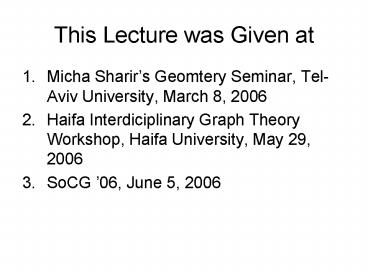This Lecture was Given at - PowerPoint PPT Presentation
1 / 16
Title:
This Lecture was Given at
Description:
Title: Colored Range Searching via Matrix Multiplication. Abstract: ... In a Sparse Rectangular Matrix Multiplication Problem, one is given a ... – PowerPoint PPT presentation
Number of Views:34
Avg rating:3.0/5.0
Title: This Lecture was Given at
1
This Lecture was Given at
- Micha Sharirs Geomtery Seminar, Tel-Aviv
University, March 8, 2006 - Haifa Interdiciplinary Graph Theory Workshop,
Haifa University, May 29, 2006 - SoCG 06, June 5, 2006
2
Lecture Abstract
- Title Colored Range Searching via Matrix
Multiplication - Abstract
- In a Colored Range Searching Problem, one is
given a set of points, each - point colored in one of c colors, and a set of
hypercubes, each colored in - one of the same c colors. The goal is to report
all pairs of colors - (c_1,c_2) such that a point of color c_1 is
contained in a cube of color - c_2. The same question can be asked for
halfspaces, triangles, etc. - In a Sparse Rectangular Matrix Multiplication
Problem, one is given a - matrix A with n rows and at most m non-zero
entries (the number of columns - is not significant). The goal is to compute
AAT, i.e. the product of A - and its transpose.
- It is relatively easy to see that the Colored
Range Searching Problem is - harder than the Sparse Rectangular Matrix
Multiplication Problem, in the - sense that one can solve the latter using the
former. In this talk we show - that this relation goes both ways. In other
words, we prove that the - optimal time it takes to solve the former problem
can be stated in terms
3
Slide with more info - History of Colored Problems
- Defined by Gupta, Janardan, Smid in beginning of
90s. - Some survey articles by GJS
- Mostly geometrical techniques
- Try to transform to an input where each pair of
color intersects only once - Some tricks to allow output-sensitivity.
- A paper on the batched problem by Bozanis,
Kitsios,Makris and Tsakalidis - (always O(nxky) where x2y2. Our algorithms
probably reduce to their when using omega3) is
this true?
4
Important to understand
- The difference between the so-called single-shot
problem and the other problems is not that one is
single-shot and the others are not. Indeed, the
others have single-shot versions too, and the
single-shot problem can have a DS version. The
different is that the single-shot problem is
colors vs. colors (and so the output size os
O(c2)), and the other problems are colors vs.
objects (and the output size is e.g. O(n) in the
counting version)
5
Research Subjects
- Output-sensitivity
- What happens if every column has sqrt(n) 1s? Find
a computational model to get a lower bound. - VC-dim, finite-representation objects, etc. Put a
reference to the compression of graphs papers
6
I. SMM CI
- Suppose that the hypercubes are degenerate so
they are also points. - So report colored points vs. colored points (no
geometry!) - Remember m points, n colors
7
SMM CI
- This is like computing union of bi-cliques over n
vertices with total size (number of vertices) m
8
SMM CI
- Computing union of bi-cliques SMM
Yellow gives
9
SMM CI
- Computing union of bi-cliques SMM
Yellow gives
10
SMM CI
- In general SMM union of bi-cliques over n
vertices with total size m - (we will use this again later for the upper
bound!)
11
II. CI SMM
- Method
- Let G(S,T) be the intersection graph
- Suppose we could prove that G(S,T) can always be
written as the (non-disjoint) union of bi-cliques
with total size m. ( an efficient algorithm to
generate this partition). Then we are finished. - Theorem The intersection graph of m points and m
hypercubes can be written as the disjoint union
of bi-cliques with total size mlogdm
12
CI SMM
- Method
- Let G(S,T) be the intersection graph
- Compute decomposition of G
- For each bi-clique compress the colors in the two
sides now the number of vertices is n, and the
total size is still m. - Now that we have bi-cliques over the colors
rather than over the geometrical objects
compute union of bi-cliques
13
CI SMM
- Theorem The intersection graph of m points and m
hypercubes can be written as the disjoint union
of bi-cliques with total size mlogdm - Proof
- Compute range tree over points.
- For each hypercube, find canonical subset
- The bi-cliques are defined by the vertices
14
Proof for 1 dimension
p5, p6, p7, p8
p1, p2
p1
p2
p3
p4
p5
p6
p7
p8
1-d range tree
p1
p2
p3
p4
p5
p6
p7
p8
15
p3 I1
p3, p4 I2
p5, p6, p7, p8 I3, I2
p2 I1,I2
p1
p2
p3
p4
p5
p6
p7
p8
1-d range tree
p1
p2
p3
p4
p5
p6
p7
p8
I3
I1
I2
16
p3 I1
p3, p4 I2
p3
I2
p4
p5, p6, p7, p8 I3, I2
p2 I1,I2
p5
p1
p2
p3
p4
p5
p6
p7
p8
I3
p6
p7
I2
These are the bi-cliques. Total number of labels
O(mlogm)! QED.
p8































